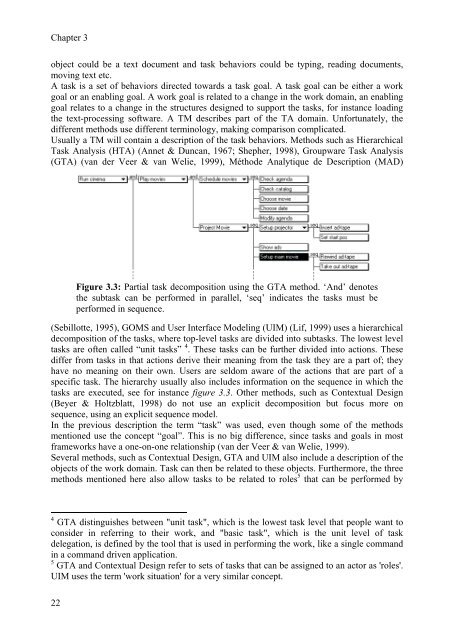Human-Computer Interaction and Presence in Virtual Reality
Human-Computer Interaction and Presence in Virtual Reality
Human-Computer Interaction and Presence in Virtual Reality
You also want an ePaper? Increase the reach of your titles
YUMPU automatically turns print PDFs into web optimized ePapers that Google loves.
Chapter 3<br />
object could be a text document <strong>and</strong> task behaviors could be typ<strong>in</strong>g, read<strong>in</strong>g documents,<br />
mov<strong>in</strong>g text etc.<br />
A task is a set of behaviors directed towards a task goal. A task goal can be either a work<br />
goal or an enabl<strong>in</strong>g goal. A work goal is related to a change <strong>in</strong> the work doma<strong>in</strong>, an enabl<strong>in</strong>g<br />
goal relates to a change <strong>in</strong> the structures designed to support the tasks, for <strong>in</strong>stance load<strong>in</strong>g<br />
the text-process<strong>in</strong>g software. A TM describes part of the TA doma<strong>in</strong>. Unfortunately, the<br />
different methods use different term<strong>in</strong>ology, mak<strong>in</strong>g comparison complicated.<br />
Usually a TM will conta<strong>in</strong> a description of the task behaviors. Methods such as Hierarchical<br />
Task Analysis (HTA) (Annet & Duncan, 1967; Shepher, 1998), Groupware Task Analysis<br />
(GTA) (van der Veer & van Welie, 1999), Méthode Analytique de Description (MAD)<br />
Figure 3.3: Partial task decomposition us<strong>in</strong>g the GTA method. ‘And’ denotes<br />
the subtask can be performed <strong>in</strong> parallel, ‘seq’ <strong>in</strong>dicates the tasks must be<br />
performed <strong>in</strong> sequence.<br />
(Sebillotte, 1995), GOMS <strong>and</strong> User Interface Model<strong>in</strong>g (UIM) (Lif, 1999) uses a hierarchical<br />
decomposition of the tasks, where top-level tasks are divided <strong>in</strong>to subtasks. The lowest level<br />
tasks are often called “unit tasks” 4 . These tasks can be further divided <strong>in</strong>to actions. These<br />
differ from tasks <strong>in</strong> that actions derive their mean<strong>in</strong>g from the task they are a part of; they<br />
have no mean<strong>in</strong>g on their own. Users are seldom aware of the actions that are part of a<br />
specific task. The hierarchy usually also <strong>in</strong>cludes <strong>in</strong>formation on the sequence <strong>in</strong> which the<br />
tasks are executed, see for <strong>in</strong>stance figure 3.3. Other methods, such as Contextual Design<br />
(Beyer & Holtzblatt, 1998) do not use an explicit decomposition but focus more on<br />
sequence, us<strong>in</strong>g an explicit sequence model.<br />
In the previous description the term “task” was used, even though some of the methods<br />
mentioned use the concept “goal”. This is no big difference, s<strong>in</strong>ce tasks <strong>and</strong> goals <strong>in</strong> most<br />
frameworks have a one-on-one relationship (van der Veer & van Welie, 1999).<br />
Several methods, such as Contextual Design, GTA <strong>and</strong> UIM also <strong>in</strong>clude a description of the<br />
objects of the work doma<strong>in</strong>. Task can then be related to these objects. Furthermore, the three<br />
methods mentioned here also allow tasks to be related to roles 5 that can be performed by<br />
4 GTA dist<strong>in</strong>guishes between "unit task", which is the lowest task level that people want to<br />
consider <strong>in</strong> referr<strong>in</strong>g to their work, <strong>and</strong> "basic task", which is the unit level of task<br />
delegation, is def<strong>in</strong>ed by the tool that is used <strong>in</strong> perform<strong>in</strong>g the work, like a s<strong>in</strong>gle comm<strong>and</strong><br />
<strong>in</strong> a comm<strong>and</strong> driven application.<br />
5 GTA <strong>and</strong> Contextual Design refer to sets of tasks that can be assigned to an actor as 'roles'.<br />
UIM uses the term 'work situation' for a very similar concept.<br />
22
















